Castle Ashby House
Castle Ashby, often Castle Ashby House (to differentiate it from the parish) is a country house at Castle Ashby, Northamptonshire, England. It is one of the seats of the Marquess of Northampton. The house, church, formal gardens and landscaped park are Grade I listed.
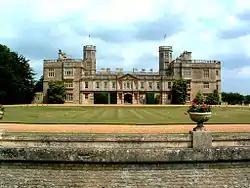
| Castle Ashby | |
|---|---|
 The façade of Castle Ashby | |
| Type | Prodigy house |
| Location | Castle Ashby, Northamptonshire |
| Coordinates | 52°13′28″N 0°44′19″W |
| Built | 1574-c.1600 |
| Architectural style(s) | Elizabethan |
| Owner | Marquess of Northampton |
| Website | https://www.castleashbygardens.co.uk |
Listed Building – Grade I | |
| Official name | Castle Ashby |
| Designated | 3 May 1968 |
| Reference no. | 1371298 |
| Official name | Castle Ashby |
| Designated | 25 June 1984 |
| Reference no. | 1000385 |
.svg.png.webp) Location of Castle Ashby in Northamptonshire | |
The original castle, a manor house, came about as the result of a licence obtained in 1306 by Walter Langton, Bishop of Coventry, to castellate his mansion in the village of Ashby. Sir Gerard Braybroke was at one time of Castle Ashby Manor.[1] It is a leading example of the Elizabethan prodigy house, with a Palladian section closing the front courtyard added in the 18th century.
History
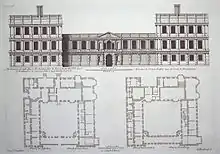
The present rebuilding of Castle Ashby was started by Henry Compton, 1st Baron Compton, in 1574[2] and was continued by his son William, created Earl of Northampton. Queen Elizabeth I's first visit to the house was in 1600. Like other houses of its time, it has an E-shaped floorplan, with a deep central porch and flight of steps forming the centre stroke of the E. This was to celebrate the coronation of Queen Elizabeth I.[2] When King James and his Queen first stayed in 1605, the castle was documented as "Lord Compton's princely mansion", and in the household records we find that employed at this time were 83 household servants, four chaplains, three musicians and the Gardener of Ashby.
The parapet of stone lettering around the top of the house is dated 1624, and its Latin inscription is:
- NISI DOMINUS CUSTOS CUSTODIVERIT DOMUM FRUSTRA
- VIGILAT QUI CUSTODIT EAM: NISI DOMINUS AEDIFICAVERIT
- DOMUM IN VANUM LABORAVERUNT QUI AEDIFICANT EAM
The words are based on the 127th Psalm, "Except the Lord build the house they labour but in vain they who build it; except the Lord keep the house the watchman waketh but in vain".[2]
By 1635 an ambitious classicising screen had been added across the open southern side of the courtyard, probably to make the two wings directly accessible to each another; its design deviates enough from Palladian canons to make it unlikely that Inigo Jones designed it;[3] Howard Colvin[4] suggested that a payment of £8 to "Cartor Surveyor" in the Earl's accounts, September 1631, may refer to Edward Carter, Jones's deputy at St. Paul's Cathedral, 1633–41. Work proceeded at Castle Ashby until, as Colen Campbell the architect put it, "the Civil Wars put a stop to all Arts".
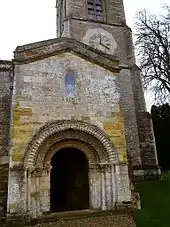
While the family was away fighting for the Royalist cause in the Civil War, the east side of the house was set on fire and severely damaged. The folklore is that an old woman known as Elspeth, who lived in the parvise over the north porch of the church, first noticed the blaze and alerted the village, thus saving the remainder of the house. The marks of the flames can still be clearly seen on the lintels of the windows. The contents of the house were looted and much damage inflicted on the estate by the Parliamentarians.
In October 1695, King William III visited the house and introduced the Dutch custom of planting avenues: not only to add to the importance of the house, but also to improve the outlook from its windows. Within a month of the visit, Lord Northampton began the planting of four avenues opposite each face of the house—something that took 25 years.
As a result of Capability Brown's "return to nature" approach 35 years later, only two of these avenues now remain. Brown, the architect and landscape gardener, was called in during 1760. Apart from "altering" the avenues into small clumps of trees and doing away with the Elizabethan gardens, he enlarged the ponds overlooked by the house into ornamental lakes, dug a ha-ha, or sunken fence, around the park and built the dairy and the temple against the menagerie. In 1771–74 the Great Hall was rebuilt for the 8th Earl by John Johnson.[5]
.JPG.webp)
It was not until the 1860s that any further substantial changes were carried out at the house, when Charles, the 3rd Marquess, and his wife brought in Sir Digby Wyatt, who made many changes to the interior of the house. Most of these were subsequently restored to their previous state by later generations who considered them ugly.
At this time the terraces round the house with their terracotta balustrading were laid out, and the Italian "golden gates" at the entrance to the front drive were hung on piers designed by Wyatt himself. However, before all the changes were carried out, Lady Northampton died of consumption, giving rise to the pitiful Latin inscription in terracotta lettering beside the church: "To Theodosia, sweetest of wives…Begun in hope, finished in despair 1865."
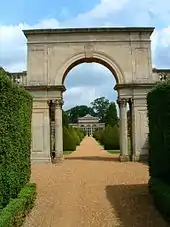
In 1867 the architect E.W. Godwin was called in to undertake further work; as a result, the Italianate Orangery and the Birmingham show houses were built to his designs. The old kitchen garden between them was also turned into an Italian garden with shaped beds divided by box edging, and the enormous kitchen garden beyond was walled in. Lodges were built approaching the station and at the entrance to the Avenue from the Northampton road. This latter pair, however, were pulled down in 1869, a year after their construction, for being too close together and were immediately rebuilt in their present position.
Later still, in the time of the 4th Marquess (1877–1897), extensive redecoration was carried out to the Long Gallery, Great Hall, Billiards Room and Chapel. Plans for the redecoration of the Long Gallery were drawn up by William Burges,[6] but these were not executed and the work was undertaken by Thomas Graham Jackson.[7]
Recent history
The Castle is closed to the public.
The house was designated as Grade I listed in 1968,[8] as was St Mary's Church.[9] The grounds were listed as Grade I on the Register of Historic Parks and Gardens in 1984.[10]
Two garden features are Grade II* listed: the Menagerie (1760s)[11] and the Terrace Gardens (1864–1866).[12]
Grounds
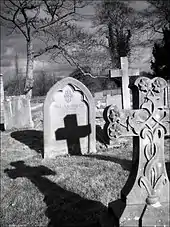
The Castle Ashby Estate is managed by Compton Estates for Lord Northampton, who remains one of the area's great landowners; the estate includes land in many of the neighbouring villages, such as Grendon, Denton and Yardley Hastings.
The Estate grounds also include a fine cricket pitch in front of the castle and a drive almost 4 miles long.
The Castle and grounds are not open to the public.
Events
The grounds provided the venue for the Greenbelt Christian music festival each year between 1984 and 1992.
Two open-air concerts were given by Sir Elton John in the grounds in front of the house in July 2000.
In popular culture
Academic Dr. Robert Clark theorized Jane Austen based her 1814 novel Mansfield Park's eponymous fictional Northamptonshire country house on Castle Ashby.[13]
The greenhouse at Castle Ashby Gardens was used for filming part of the film Men in Black: International, doubling as part of Riza's Castle.[14]
See also
Notes
- Birch, Walter de Gray (1892). Catalogue of seals in the Department of manuscripts in the British museum. British Museum, Dept. of Manuscripts. pp. 553–. Retrieved 7 July 2011.
- "History". Welcome to Castle Ashby Gardens. Archived from the original on 20 October 2010. Retrieved 18 March 2011.
- Gervase Jackson-Stops in Country Life 30 January 1986.
- Colvin, A Biographical Dictionary of British Architects, 1600–1840 3rd ed. 1995, sub Edward Carter.
- It was altered again in 1884. (Colvin 1995, sub John Johnson).
- Crook 1981a, "Appendix B"
- Cherry & Pevsner 1973, p. 143.
- Historic England. "Castle Ashby (1371298)". National Heritage List for England. Retrieved 9 October 2017.
- Historic England. "Church of St Mary Magdalen (1294095)". National Heritage List for England. Retrieved 9 October 2017.
- Historic England. "Castle Ashby – Parks and Gardens (1000385)". National Heritage List for England. Retrieved 9 October 2017.
- Historic England. "The Menagerie (1189885)". National Heritage List for England. Retrieved 9 October 2017.
- Historic England. "Terrace Gardens (1189676)". National Heritage List for England. Retrieved 9 October 2017.
- Furness, Hannah (3 September 2015). "Revealed: the real inspiration for Jane Austen's Mansfield Park". The Daily Telegraph. Retrieved 5 May 2018.
- "Northamptonshire on the big screen: The films that put the county on the movie map". Northampton Chronicle. 9 August 2020. Retrieved 27 December 2020.
References
- Cherry, Bridget; Pevsner, Nikolaus (1973). The Buildings of England: Northamptonshire. New Haven, CT; London: Yale University Press. ISBN 0300096321. ASIN 0300096321.
- Crook, J. Mordaunt (1981a). William Burges and the High Victorian Dream. John Murray. ISBN 978-0-7195-3822-3.